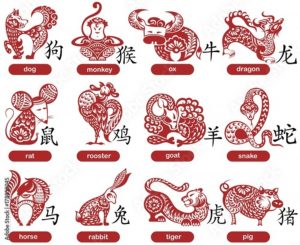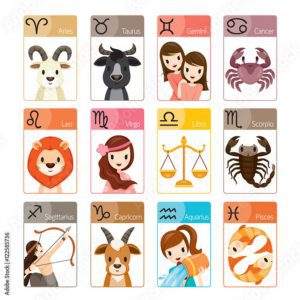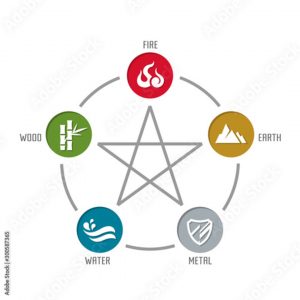Comparison between Chinese Zodiac and Western Astrology
With the Chinese New Year approaching, and 2022 being the year of the tiger, it is worthwhile to try to understand the Chinese zodiac, a divinatory scheme that differs from Western astrology.

The main similarities between the two schemes are that both are based on the date and time of birth, and both use 12 symbols or signs to communicate meaning. To help you understand the differences, we’ve listed some of the most significant ones.
The 12 Signs
There is the same number of signs in both systems: 12. Ox/Bull and Goat/Ram are two that appear to be similar.
Rat, Ox, Tiger, Rabbit, Dragon, Snake, Horse, Goat, Monkey, Rooster, Dog, and Pig are the Chinese zodiac signs.
The Western signs are Ram, Bull, Twins, Crab, Lion, Virgin, Scales, Scorpion, Centaur, Sea-Goat, Water Bearer, and Fish.
The year 2020 is the Rat, the year 2021 is the Ox, and the year 2022 is the Tiger.


The Signs’ Origins
The 12 signs of Chinese astrology are derived from a myth that when God was developing a calendar, all creatures on Earth were summoned to compete in a race. The first 12 people to cross the finish line were given Chinese zodiac signs.
This differs from Western astrology, which bases the 12 signs on the positions of the constellations relative to the earth. Greek mythology was used to name the constellations.
Another Comparison: Zodiac Months
On the traditional Chinese solar calendar, the Chinese zodiac animals were assigned months. For a period, similar to a Western zodiac month, each animal sign corresponds with two of the 24 solar terms.
This means that the Western astrological signs and Chinese zodiac months overlap by a half-month, as shown in the diagram to the right.
More Than Your Birth Year and Month
Signs are divided per month in the simplified Western astrological framework, whereas Chinese signs are divided year by year in popular astrology. This means that people born in the same year have similar traits in Chinese beliefs, as opposed to those born in the same month-long time frame in Western beliefs.
Of course, there’s more to it than that. Aside from the constellations, planets, for example, represent basic motivations in the human psyche in Western astrology. Aside from the yearly zodiac, Chinese astrology has three other pillars that influence your fate, totaling four: birth year, birth month, birth day, and birth hour.
The main difference between the four pillars and Western astrology is that Western astrology focuses on celestial alignment (of constellations with planets, stars, the moon, and so on), whereas the four pillars are based on the alignment of blocks of time in the Chinese calendar.
Lunar, But Mostly Solar
Each month in the famous Chinese astrology system (the lunar calendar) begins with a new moon and lasts 29 or 30 days. In comparison to a solar calendar, the Chinese New Year date and length of a lunar year vary by up to a month.
However, when it comes to making predictions and laying out horoscopes, “professional” or traditional Chinese astrology primarily uses the traditional solar calendar. A year begins on February 4th in this method (within a day).
The Western astrological calendar is based on the Earth’s orbit around the sun (and the resulting celestial alignment), which gives each zodiac month a fixed date (within a day) and a duration of 29 to 31 days. As a result, Western zodiac star signs are also referred to as sun signs.
Chinese and Western Lunar Phases
The lunar phase at the time of your birth is important in Chinese astrology. The moon is divided into four phases: new moon, waxing moon, full moon, and waning moon. New moon people prefer innovative environments, waxing moon people are hardworking, full moon people are diplomatic, and waning moon people prefer peaceful surroundings.
In comparison, the Western system considers two moon nodes: the North or Ascending Node and the South or Descending Node. While they continue to play a role in sensitive areas, the planets are viewed as more important factors in Western astrology.
The Elements
Fire, earth, metal, water, and wood are the five elements identified by Chinese astrology. Each element is associated with driving forces in your life.
The entire Chinese zodiac-element cycle lasts 60 years because the animals have 12-year cycles and there are five elements. Depending on your birth year, each sign has a fire, earth, metal, water, and wood variety. The year 2022 is a Tiger.
- Fire signs are motivated by excitement.
- Earth signs are driven to lay solid foundations.
- Metal signs are used to establish order.
- Water signs are naturally drawn to form emotional bonds.
- Those born under the Wood element have a strong desire to travel

Only four elements are identified in the Western system: fire, earth, air, and water, and each element is associated with three signs with psychological characteristics. Each sign is associated with one element.
- Water signs are influenced by emotion.
- Earth signs are useful.
- Fire signs are rash, and
- The air signs are intellectually inclined.

Furthermore, The Western Zodiac begins with Aries, the sign that heralds the start of the Spring Equinox. It concludes with Pisces. The Eastern Zodiac starts with the sign that won the first race: the Rat. It ends with the Pig, who was the last. The month of your birth determines your Sun sign in Western Astrology. The year you were born determines your sign in Eastern Astrology.
The Western Zodiac is ruled by the Solar (Sun) Calendar, with the first sign of the year beginning at the Spring Equinox. Winter has passed; spring has arrived. Meanwhile, the Lunar (Moon) Calendar governs the Eastern Zodiac, where the year begins with the Chinese New Year, which is always the second New Moon after the winter solstice.
So, how does each Chinese Zodiac sign correspond to its Western counterpart?
Jupiter is heavily involved. Jupiter travels through the Western Zodiac in twelve years, spending approximately one year in each sign. It spends the Year of the Ox in Capricorn, the Year of the Snake in Taurus, the Year of the Rat in Sagittarius, and so forth.
